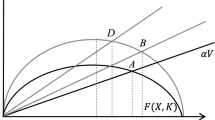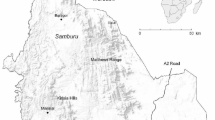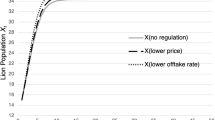Abstract
This paper formulates a bio-economic model to analyze community incentives for wildlife management under benefit-sharing programs like the Communal Areas Management Programme for Indigenous Resources (CAMPFIRE) in Zimbabwe. Three agents influence the wildlife stock: a parks agency determines hunting quotas, outside poachers hunt illegally, and a local community may choose to protect wildlife by discouraging poaching. Wildlife generates revenues from hunting licenses and tourism; it also intrudes on local agriculture. We consider two benefit-sharing regimes: shares of wildlife tourism rents and shares of hunting licenses. Resource sharing does not necessarily improve community welfare or incentives for wildlife conservation. Results depend on the exact design of the benefit shares, the size of the benefits compared with agricultural losses, and the way in which the parks agency manages hunting quotas.
Similar content being viewed by others
References
Baland JM, Platteau JP (1996) Halting degradation of natural resources: is there a role for rural communities. Clarendon Press, Oxford
Barrett CB, Arcese P (1998) Wildlife harvest in integrated conservation and development projects: linking harvest to household demand, agricultural production, and environmental shocks in the Serengeti. Land Econ 74: 449–465
Brandon K, Wells M (1992) Planning for people and parks: design dilemmas. World Dev 20: 557–570
Bulte EH, Horan RD (2003) Habitat conservation, wildlife extraction and agricultural expansion. J Environ Econ Manage 45(1): 109–127
Bulte EH, van Kooten GC (1999) Economics of antipoaching enforcement and the ivory trade ban. Am J Agric Econ 81(2): 453–466
Child B (1995) Guidelines for managing communal lands wildlife revenues in accordance with policy for wildlife. Department of National Parks and Wildlife Management, Harare, Zimbabwe
Cumming DHM (1989) Commercial and safari hunting in Zimbabwe. In: Hudson RJ, Drew KR, Bodkin LM (eds) Wildlife production systems: economic utilisation of wildlife. Cambridge University Press, Cambridge
Duffy R (2000) Killing for conservation: wildlife policy in Zimbabwe. The International African Institute and Weaver Press, Harare
Emerton L (2001) The nature of benefits and benefits of nature: why wildlife conservation has not economically benefited communities in Africa. In: Hulme D, Muphree M (eds) African wildlife and livelihoods: the promise and performance of community conservation. Weaver Press, Harare
Ferraro PJ (2001) Global habitat protection: limitations of development interventions and a role for conservation performance payments. Conserv Bio 15(4): 990–1000
Ferraro PJ, Simpson D (2002) The cost-effectiveness of conservation payments. Land Econ 78(3): 339–353
Horan RD, Bulte EH (2004) Optimal and open-access harvesting of multi-use species in a second-best world. Environ Resour Econ 28(3): 251–272
Johannesen AB (2004) Designing integrated conservation and development projects (ICDPs): illegal hunting, wildlife conservation and the welfare of the local people. Working paper series no. 2/2004. Norwegian University of Science and Technology, Department of Economics, Trondheim, Norway
Johannesen AB, Skonhoft A (2005) Tourism, poaching and wildlife conservation: what can integrated conservation and development projects accomplish?. Environ Resour Econ 27: 208–226
Khanna J, Harford J (1996) The ivory trade ban: is it effective. Ecol Econ 19: 147–155
Kinyua PID, van Kooten GC, Bulte EH (2000) African wildlife policy: protecting wildlife herbivores on private game ranches. Eur Rev Agric Econ 27(2): 227–244
Milner-Gulland EJ, Leader-Williams N (1992) A model of incentives for the illegal exploitation of black rhinos and elephants: poaching pays in Luangwa Valley. Zambia J App Ecol 29: 388–401
Muller J, Albers HJ (2004) Enforcement, payments, and development projects near protected areas: how the market setting determines what works where. Resour Energ Econ 26: 185–204
Ostrom E (2000) Collective action and the evolution of social norms. J Econ Perspect 14(3): 137–158
Rondeau D, Conrad J (2003) Managing urban deer. Am J Agric Econ 85: 266–281
Sellenthin MO, Skogh G (2004) Property rights in endangered species: the wolverine case. Eur J Law Econ 18(2): 239–247
Shulz C-E, Skonhoft A (1996) Wildlife management, land use and conflicts. Environ Develop Econ 1(3): 265–280
Skonhoft A (1998) Resource utilisation, property rights and welfare—wildlife and the local people. Ecol Econ 26: 67–80
Skonhoft A, Solstad JT (1996) Wildlife management, illegal hunting and conflicts. Environ Develop Econ 1(2): 165–181
Skonhoft A, Solstad JT (1998) Investing in wildlife: can wildlife pay its way?. J Afric Econ 7(2): 237–262
Swallow S (1990) Depletion of the environmental basis for renewable resources: the economics of interdependent renewable and non-renewable resources. J Environ Econ Manage 19: 281–296
Swanson T (1993) Regulating endangered species. Econ Policy 8(16): 185–205
Taylor RD (2006) Case study: CAMPFIRE (communal areas management programme for indigenous resources), Zimbabwe. Available at http://www.irgltd.com/Resources/Publications/Africa/Zimbabwe%20paper%20final%20draft%20v3.pdf
WWF (1997) Quota setting manual. Wildlife management series. World wide fund for nature (formerly world wildlife fund). Programme Office, Zimbabwe, Zimbabwe Trust and Safari Club International
Author information
Authors and Affiliations
Corresponding author
Additional information
This paper has not been submitted elsewhere in identical or similar form, nor will it be during the first three months after its submission to the Publisher.
Rights and permissions
About this article
Cite this article
Fischer, C., Muchapondwa, E. & Sterner, T. A Bio-Economic Model of Community Incentives for Wildlife Management Under CAMPFIRE. Environ Resource Econ 48, 303–319 (2011). https://doi.org/10.1007/s10640-010-9409-y
Accepted:
Published:
Issue Date:
DOI: https://doi.org/10.1007/s10640-010-9409-y
Keywords
- Bio-economics
- Benefit sharing
- CAMPFIRE
- Conservation
- Elephants
- Hunting quotas
- Poaching
- Renewable resources
- Wildlife




